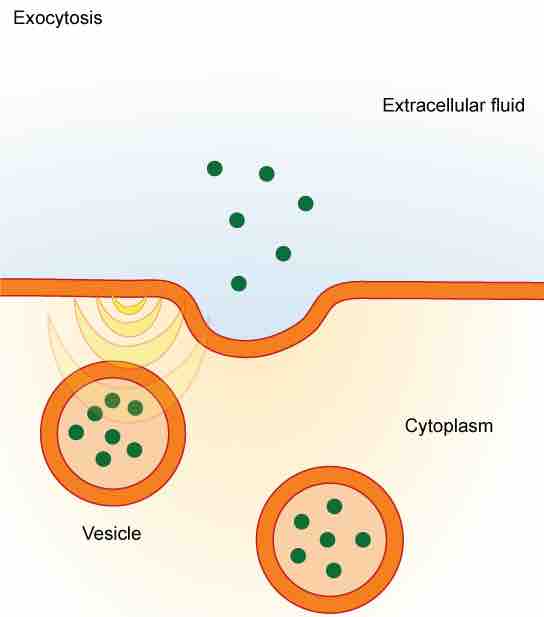Exocytosis
Exocytosis' main purpose is to expel material from the cell into the extracellular fluid; this is the opposite of what occurs in endocytosis. In exocytosis, waste material is enveloped in a membrane and fuses with the interior of the plasma membrane. This fusion opens the membranous envelope on the exterior of the cell and the waste material is expelled into the extracellular space . Exocytosis is used continuously by plant and animal cells to excrete waste from the cells.

Exocytosis
In exocytosis, vesicles containing substances fuse with the plasma membrane. The contents are then released to the exterior of the cell.
Exocytosis is composed of five main stages. The first stage is called vesicle trafficking. This involves the steps required to move, over a significant distance, the vesicle containing the material that is to be disposed. The next stage that occurs is vesicle tethering, which links the vesicle to the cell membrane by biological material at half the diameter of a vesicle. Next, the vesicle's membrane and the cell membrane connect and are held together in the vesicle docking step. This stage of exocytosis is then followed by vesicle priming, which includes all of the molecular rearrangements and protein and lipid modifications that take place after initial docking. In some cells, there is no priming. The final stage, vesicle fusion, involves the merging of the vesicle membrane with the target membrane. This results in the release of the unwanted materials into the space outside the cell.
Some examples of cells releasing molecules via exocytosis include the secretion of proteins of the extracellular matrix and secretion of neurotransmitters into the synaptic cleft by synaptic vesicles. Some examples of cells using exocytosis include: the secretion of proteins like enzymes, peptide hormones and antibodies from different cells, the flipping of the plasma membrane, the placement of integral membrane proteins(IMPs) or proteins that are attached biologically to the cell, and the recycling of plasma membrane bound receptors(molecules on the cell membrane that intercept signals).